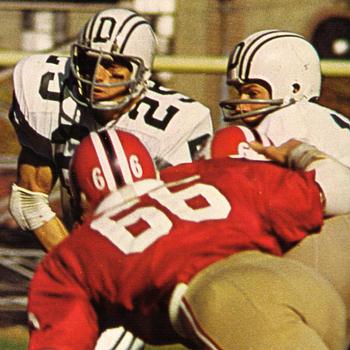

Dartmouth
1960s Big Green
(Authentic Reproduction)
|
|
 |
College Football Hall Of Fame coach Bob Blackman was used to overcoming and changing. Leaving DeSoto, Iowa for what must been the geographical extreme of the University Of Southern California, the young end became captain of the Trojan Freshmen football team. His career however, was halted when he contracted polio, a life threatening disease, often fatal and crippling, during the 1930’s when young Blackman was stricken and one not controlled until the advent of effective vaccines in the mid-1950’s. He remained part of the football program, serving as an assistant coach until his graduation, and he then went on to coach at the San Diego Naval Academy and Pasadena City College as an assistant. He moved to Denver University as their head coach in 1953 and after two successful seasons, became the head coach at Dartmouth College in Hanover, New Hampshire. After five losing seasons, the Big Green was ready for the change but no one could have predicted Bob “The Bullet’s” success. Seven Ivy League Championships, two Lambert Trophies (as the Best Team In The East), and only two losing seasons in sixteen years paved the way for Blackman’s entry to the Hall Of Fame. To many in the Dartmouth family, he remains as well remembered as alumni such as the former Vice President and New York State Governor Nelson Rockefeller and Surgeon General C. Everett Koop.
He had helped to turn
poor programs around at every stop and with talent obvious enough to have
the great Paul Brown recommend him for the Dartmouth job and then send his
son Mike, the current owner of the Cincinnati Bengals off to play for him,
perhaps his success should have been expected. Credited with developing the
tackle eligible play, cross field lateral passes, the V-Formation, and a try
at using thick soled rubber shoes for running backs to launch themselves
over opposing lines, his creative mind never ceased to work and surprise his
professional colleagues.
|
|
|
Certainly his 1965 helmet design, one that
became immediately associated with Dartmouth and remains so to this day, was one
of those fertile and creative ideas. The design used by Blackman was a departure
from what was usually seen. When he came to the Dartmouth campus, he rapidly
phased out the leather helmets that were used previously and introduced the
Riddell white plastic shell with two forest green flanking stripes. Through the
1964 season, this design, with player identification numerals on both sides, was
the Big Green standard. In ’65, Blackman’s squad took the field in a white shell
with parallel green striping, two forest green stripes per side and the block
letter “D” on the front. As noted in HELMET HUT’s
Ask Dr. Del Rye column of October 2010 [ see
http://www.helmethut.com/DrDelrye/103110.html
]
this great design became “as
much of a trademark as Michigan’s famed ‘winged helmet’.”
|
|
|
The very distinctive
helmet, coupled with Blackman’s impressive 104-37-3 record at Dartmouth, put
this design in the Ivy League forefront and he carried it with him, altering
the Illinois and Cornell helmets on his subsequent coaching stops at those
programs. The authentic reproduction of the late 1960’s Riddell TK 2 helmet,
flaunts the beautiful Dartmouth striping and block D, a source of pride for
all who in any way, have or feel a connection to The Big Green.